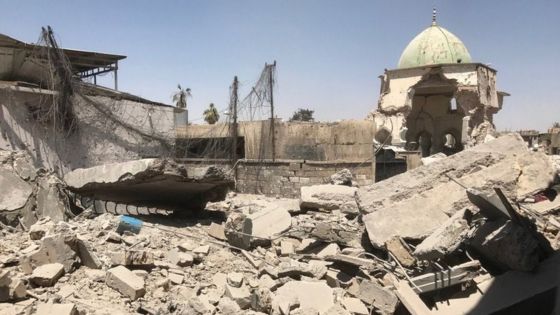
Iraqi security forces have entered the site of the destroyed Great Mosque of al-Nuri in Mosul after driving back militants from so-called Islamic State.
BBC Arabic`s Feras Kilani, who is embedded with troops there, says the complex has not yet been secured and is exposed to IS sniper and mortar fire.
Militants blew up the medieval mosque and its landmark leaning minaret last week as troops advanced towards it.
But the site is still of great symbolic importance to both sides in the battle.
Abu Bakr al-Baghdadi made his only public appearance as IS leader there days after the jihadist group proclaimed the creation of a "caliphate" exactly three years ago.
IS is now in retreat across Iraq and neighbouring Syria, where a US-backed alliance of Kurdish and Arab fighters is laying siege to its de facto capital of Raqqa.
Pro-government forces launched an offensive to retake Mosul in October with air and ground support from a US-led multinational coalition.
They managed to take full control of the eastern half of Mosul in January and started an assault on the west the following month.
Only a few hundred militants are now believed to be left in about 1 sq km (0.4 sq miles) of the Old City, along with some 50,000 civilians who humanitarian organisations say have little food or water and are at great risk of injury or death.
Our correspondent says units from the Counter-Terrorism Service (CTS), Emergency Response Division (ERD), Federal Police and Iraqi Army began what they called the "final battle" for the Old City on Thursday.
The assault reportedly triggered clashes fighting throughout the morning, with IS militants holding strong defensive positions, he adds.
The overall commander of the offensive, Lt Gen Abdul Amir Yarallah, soon declared that CTS troops had taken control of what remained of the Nuri mosque, as well as the Sirjkhana district.
But it was until several hours later that troops entered the mosque complex, our correspondent says.
The Great Mosque was named after Nur al-Din Mahmoud Zangi - famous for mobilising and unifying Muslim forces to wage jihad against the Christian Crusaders - who ordered its construction in 1172, shortly before his death.
Despite its connection to such an illustrious figure, all that remained of the original mosque was its leaning minaret - nicknamed "al-Hadba", or "the humpback" - some columns and the mihrab, a niche indicating the direction of Mecca.
The Iraqi military said IS militants blew up the mosque and minaret eight days ago, leaving only the base of the minaret and a dome supported by a few pillars.
IS accused the US-led coalition aircraft of bombing the site, but experts said a video circulated online appeared to show charges inside the structures exploding.
Prime Minister Haider al-Abadi called the mosque`s destruction "an official declaration of defeat" by the jihadist group.


0 comments:
Post a Comment